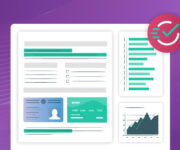The lending and financial landscape are evolving thick and fast all over the globe. The rate has almost been exponential last year due to the pandemic-borne realignments. For a lending institution to have a tech-savvy mobile app and a digital lending strategy is no longer “good to have” but has become a “must-have”.
The potential borrowers are no longer restricted to a particular geography or a working class. With the digital world seamlessly connecting people worldwide, the opportunities for lending institutions have also increased drastically.
But the irony is, the number of defaulters has also increased proportionately to the increase in customer base. So for financial institutions to lend to a reliable borrower, an informed credit analysis using a reliable indicator like “CIBIL Score” continues to play an important deciding factor.
CIBIL Score and Limitations in Legacy Credit Scoring Models
CIBIL score is one of the most reliable indicators of one’s creditworthiness. Simply put, it is a three-digit number that reflects a customers’ credit history.
Payments on time and ahead of due dates consistently improves one’s CIBIL score. Credit scoring bureaus aim to create a model that can predict how safe it is to lend to a potential borrower. Though the credit scoring algorithms have evolved so much from where they started, they have a big threat in the form of cybercriminals.
With the technology available at fingertips even for cybercriminals and fraudsters, the number of ID thefts has increased substantially. Fraudsters increasingly use such stolen identities, which have good credit scores, to apply for loans from lending institutions whose loan analysis system is not so strong to capture such illegal activities.
This has led to the adoption of lending institutions to go for a data-based analysis in addition to traditional credit score based models for credit decisions.
Digital Footprints and how it can augment CIBIL score
Digital Footprint refers to one’s unique set of traceable digital activities. This includes all the activities like browsing websites using computers, laptops, smartphones, tabs, and any other digital devices used to surf the internet. This includes communications, posts, and other participation by individuals in social media and online shopping websites.
Types of Digital Footprints
Digital Footprints are of two types – Active and Passive.
Active digital footprint refers to the users’ activities deliberately like posting a video or text on social media, sending a broadcast communication, posting blogs, etc.
Passive digital footprint refers to the information stored in one’s browsers as cookies simply by visiting or registering on some websites.
With the increase in digital activities worldwide, there is a lot of data available for financial institutions on their borrowers or potential borrowers. Ethical and acceptable access to such digital footprint data opens up new avenues for effective credit analysis for financial institutions.
There are financial institutions, who use both the traditional CIBIL score and the digital footprint as well to arrive at a final score of the customer’s creditworthiness.
Benefits of Digital Footprint based credit scoring

1. Reach the Unbanked
A popular study done in 2018 indicates that around 2 billion working-age adults worldwide lack access to financial assistance, mainly due to the nonavailability of CIBIL score. Out of these unbanked populations, most youth or students do not have any financial footprint or documents to substantiate their ability to repay a loan. This is where Fintech companies and some banks have started utilising digital footprint data of the potential borrowers who don’t have a traditional CIBIL score, to arrive at a creditworthiness score.
2. Ability to repay versus willingness to repay
Almost every website can effortlessly track whether the website is accessed from a pc or smartphone and if smartphone, whether it’s iOS or Android. Based on the device’s model from which a user browses digital often and based on the kind of websites one frequently visits and the interactions done in public social forms, one can make an informed decision of a potential borrower’s social behaviour. This data on a person’s behavioural pattern when mined and analysed with advanced tools indicates one’s willingness to repay loans. This way, even if a potential borrower does not have a CIBIL score available, but has the desire to repay has a better chance of getting loans.
3. Feeder for Advanced Machine Learning Tools
Enhanced technologies like data mining, analysis, and machine learning can use the digital footprint data and compare with a consistently defaulting borrower’s behaviour and arrive at a creditworthiness score. Some examples include combinations such as high storage and the latest phone model and a very less online time, etc. Hundreds of such combinations can be created as a benchmark and compared with the customers’ digital footprint.
4. Enhanced Customer Experience
Some borrowers have bad CIBIL scores because they were financially low during a particular phase of their life. As they improve financially, their CIBIL score also improves proportionately. Yet if there is a borrowing need for a customer with a low CIBIL score, the lending institutions can use the digital footprint data to conclude on the person’s creditworthiness. This will lead to an increase in the borrower base and a morale booster for the borrower.
In conclusion, the CIBIL score is here to stay and evolve even further. But for the lending industry to reach the unbanked sections, traditional CIBIL score based assessment alone may not suffice. A simple go-to solution for credit decisions is expected to evolve in the coming decade, which will be a combination of both legacy-based CIBIL score and digital data-based credit score.
With the digital footprint of individuals increasing every minute and Artificial Intelligence, Machine Learning, and Deep Learning technologies evolving every day, a reliable digital footprint would supplement the CIBIL score to make informed credit decisions. For those without CIBIL scores, a healthy digital footprint alone can be used to access the willingness to repay, thereby making better-informed credit decisions.
When it comes to managing loan origination and lending lifecycle management, Finezza’s suite of products can make your processes simpler and risk-free. Contact us at Finezza to know more about how we can help your lending business.




Leave a Reply